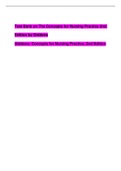Exam (elaborations)
Giddens: Concepts for Nursing Practice, 2nd Edition/Test Bank on The Concepts for Nursing Practice 2nd Edition by Giddens
- Course
- Institution
- Book
Giddens: Concepts for Nursing Practice, 2nd Edition/Test Bank on The Concepts for Nursing Practice 2nd Edition by Giddens Giddens: Concepts for Nursing Practice, 2nd Edition Test Bank on The Concepts for Nursing Practice 2nd Edition by Giddens Health Disparities Concept 54: Health Disparities Gidd...
[Show more]




